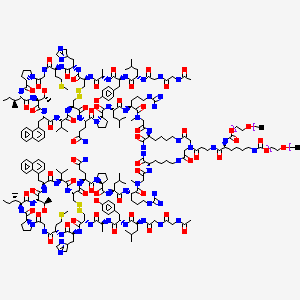CASRN: 913976-27-9

Drug Levels and Effects
Summary of Use during Lactation
No information is available on the clinical use of peginesatide during breastfeeding. Because of its large molecular weight of 4900 daltons, excretion into breastmilk should be minimal and it would not be expected to be absorbed from breastmilk by the infant. Polyethylene glycol is not excreted into breastmilk.[1] However, until more data become available, an alternate drug may be preferred, especially while nursing a newborn or preterm infant.
Drug Levels
Maternal Levels. Relevant published information was not found as of the revision date.
Infant Levels. Relevant published information was not found as of the revision date.
Effects in Breastfed Infants
Relevant published information was not found as of the revision date.
Effects on Lactation and Breastmilk
Relevant published information was not found as of the revision date.
Alternate Drugs to Consider
References
- 1.
- Clowse ME, Förger F, Hwang C, et al. Minimal to no transfer of certolizumab pegol into breast milk: Results from CRADLE, a prospective, postmarketing, multicentre, pharmacokinetic study. Ann Rheum Dis. 2017;76:1890–6. [PMC free article: PMC5705850] [PubMed: 28814432]
Substance Identification
Substance Name
Peginesatide
CAS Registry Number
913976-27-9
Drug Class
Breast Feeding
Lactation
Colony-Stimulating Factors
Hematinics
Hematopoietic Cell Growth Factors
Disclaimer: Information presented in this database is not meant as a substitute for professional judgment. You should consult your healthcare provider for breastfeeding advice related to your particular situation. The U.S. government does not warrant or assume any liability or responsibility for the accuracy or completeness of the information on this Site.
Publication Details
Publication History
Last Revision: January 18, 2022.
Copyright
Attribution Statement: LactMed is a registered trademark of the U.S. Department of Health and Human Services.
Publisher
National Institute of Child Health and Human Development, Bethesda (MD)
NLM Citation
Drugs and Lactation Database (LactMed®) [Internet]. Bethesda (MD): National Institute of Child Health and Human Development; 2006-. Peginesatide. [Updated 2022 Jan 18].